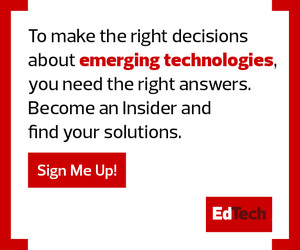I realize that some in the education field might believe more movement is a gateway to more horseplay. Adding movement does create excitement and energy, but that’s the point. We cannot hold up the quiet classroom as the ideal; it only reinforces the principles of “sit and get.” At the same time, embracing some noise doesn’t mean anything goes. Creating structured opportunities — for example, a conga line or a hallway science exhibit — can help encourage movement while minimizing chaos.
The Benefits of Technology and Movement
Overall, research has shown that the advantages of adding technology-enabled movement outweigh the risks.
Technology on its own has many benefits for students. It can increase student engagement, collaboration, creativity, choice and personalization.
MORE ON EDTECH: What are the benefits of integrating technology for students?
Researchers, educators and administrators have also documented the benefits of movement in the classroom. Movement impacts aspects of learning from focus, motivation and concentration to engagement, mental health and behavior. Research shows moving around can also boost academic performance, particularly in areas of memory, recall and math problem-solving.
When educators and administrators combine technology with movement, they are helping to break down the walls between physical and digital learning experiences, amplifying the benefits of both.
What to Use to Encourage Movement
There are many creative ways to combine technology and movement in the classroom, and with the right tools, it is easy to do. Here are a few technologies I’ve found to be effective.
QR codes
QR codes are great for adding movement and action for students, and they are easy to create. Google and Windows offer free code generators, and the websites QR Code Generator and QR Tiger also generate QR codes for free. I have used QR codes in presentations to ask questions or poll students, posted them on bulletin boards to provide more information and used them during high-movement activities such as scavenger hunts and escape rooms.
Magnetic tablet cases
As students get up and move around, often they need ways to bring technology with them. Carrying cases and protective covers keep devices safe in these instances. In classrooms where students are using tablets, a magnetic case makes it easier for them to engage in learning away from their desks. The Logitech Rugged Combo 3 keeps tablets secure on lockers or a magnetic whiteboard as students participate in activities out of their seats.
Game-based approaches
Interactive games are great ways to add movement to a classroom. I especially like games that focus on small movements, because some students fidget but might not be excited about standing or making big gestures. For these students, games that incorporate smaller gestures, such as hand movements, are impactful.
WATCH NOW: This inclusive esports arena helps K–12 students foster connections.
Styluses
As students move around, finding opportunities to enhance the benefits they get from moving can make this approach even more impactful. Incorporating the use of a stylus is one way I’ve found to do that. When students get up from their desks to participate in movement-based activities, educators can keep activities fresh by incorporating drawing or note-taking with styluses. I’ve found that drawing in general is a great kinesthetic opportunity to engage students. I like to include these tech tools in activities such as scavenger hunts and educational escape rooms, so students can tap into their own creativity as they move.
Combining technology and movement creatively can lead to significant benefits for students, but that doesn’t mean educators have to make dramatic changes right away. Introducing one or two movement-based activities and building from there will make it easier to realize the benefits of pairing technology and movement. Gradually introducing these types of activities can help educators sustain the approach for long-term impact.











